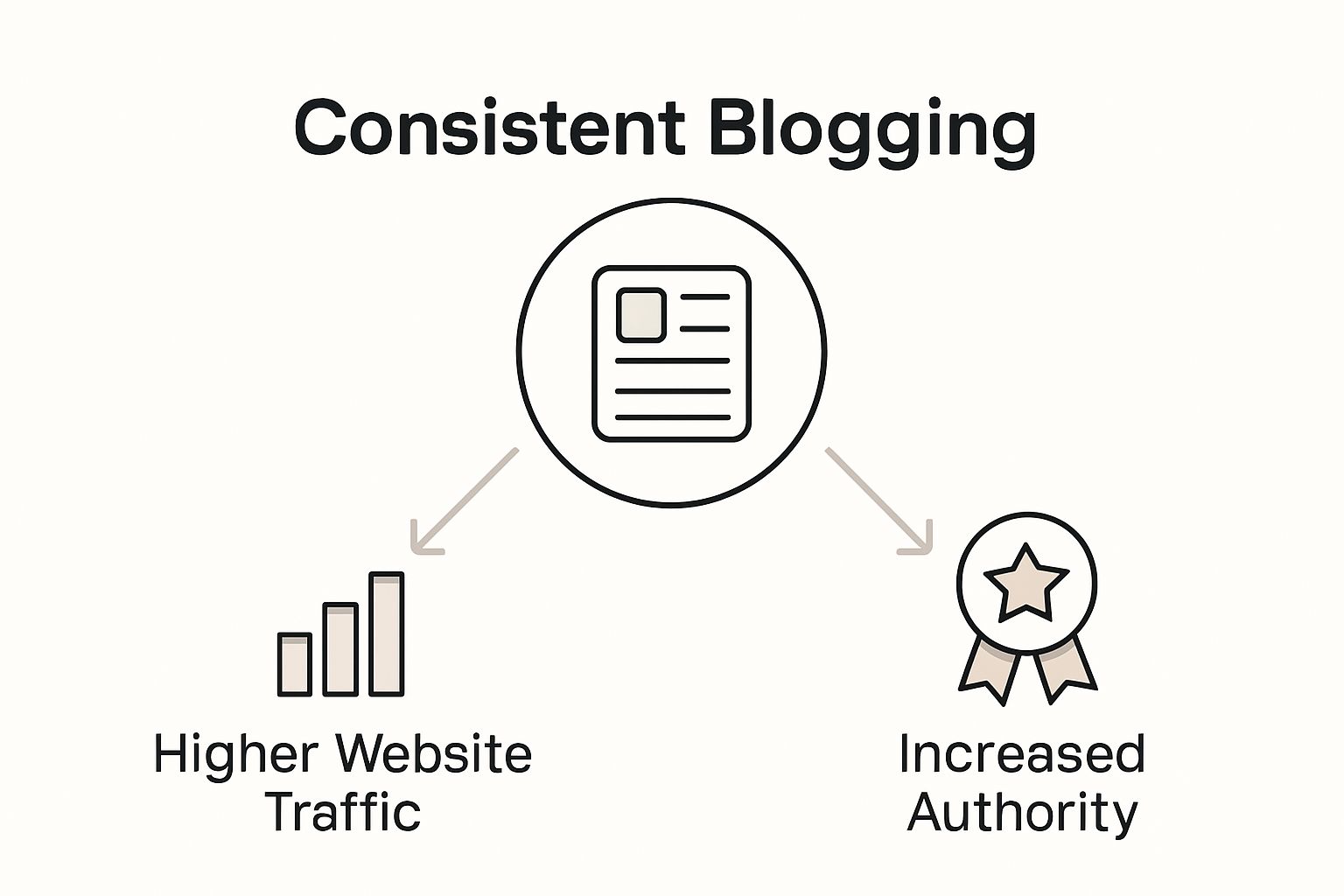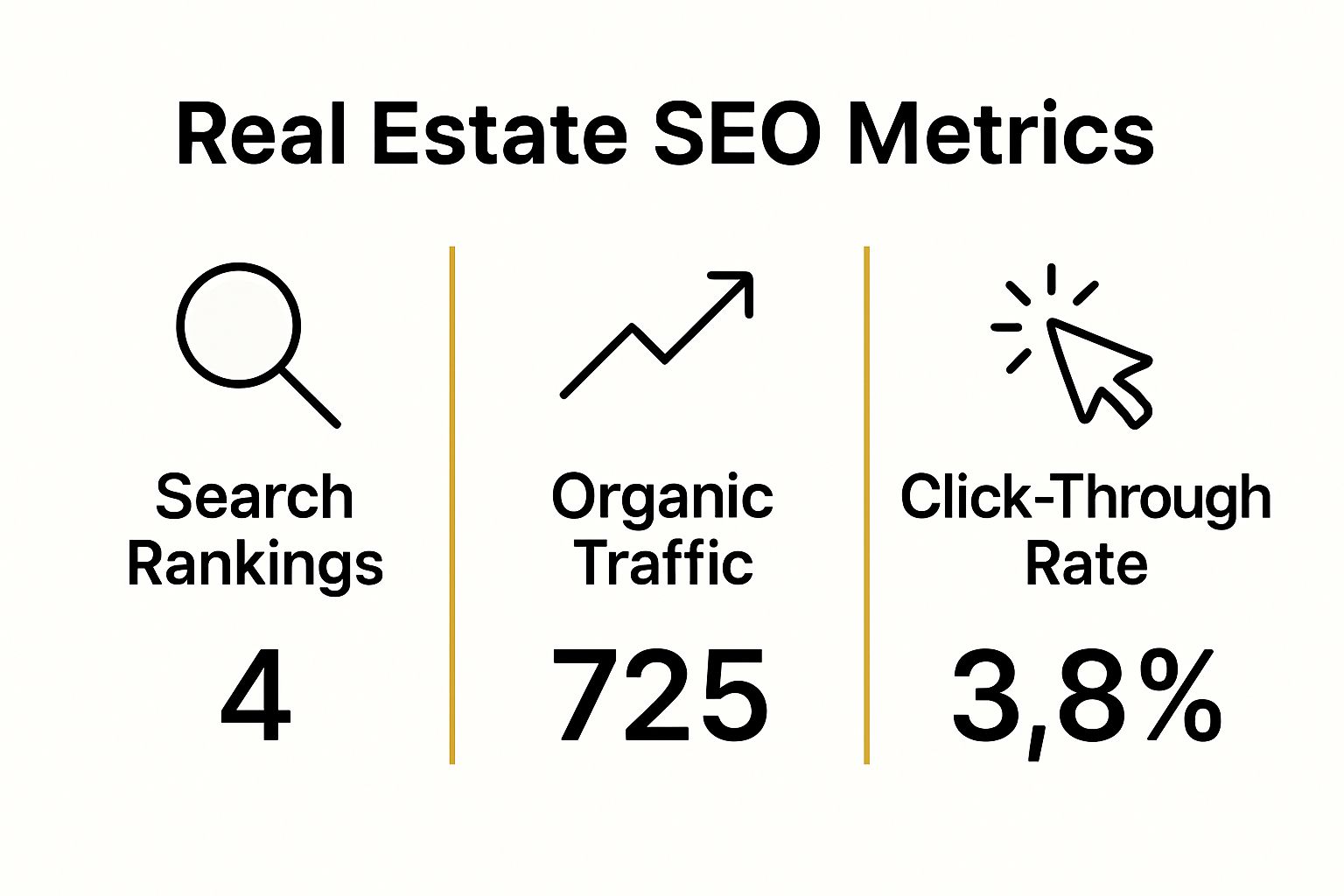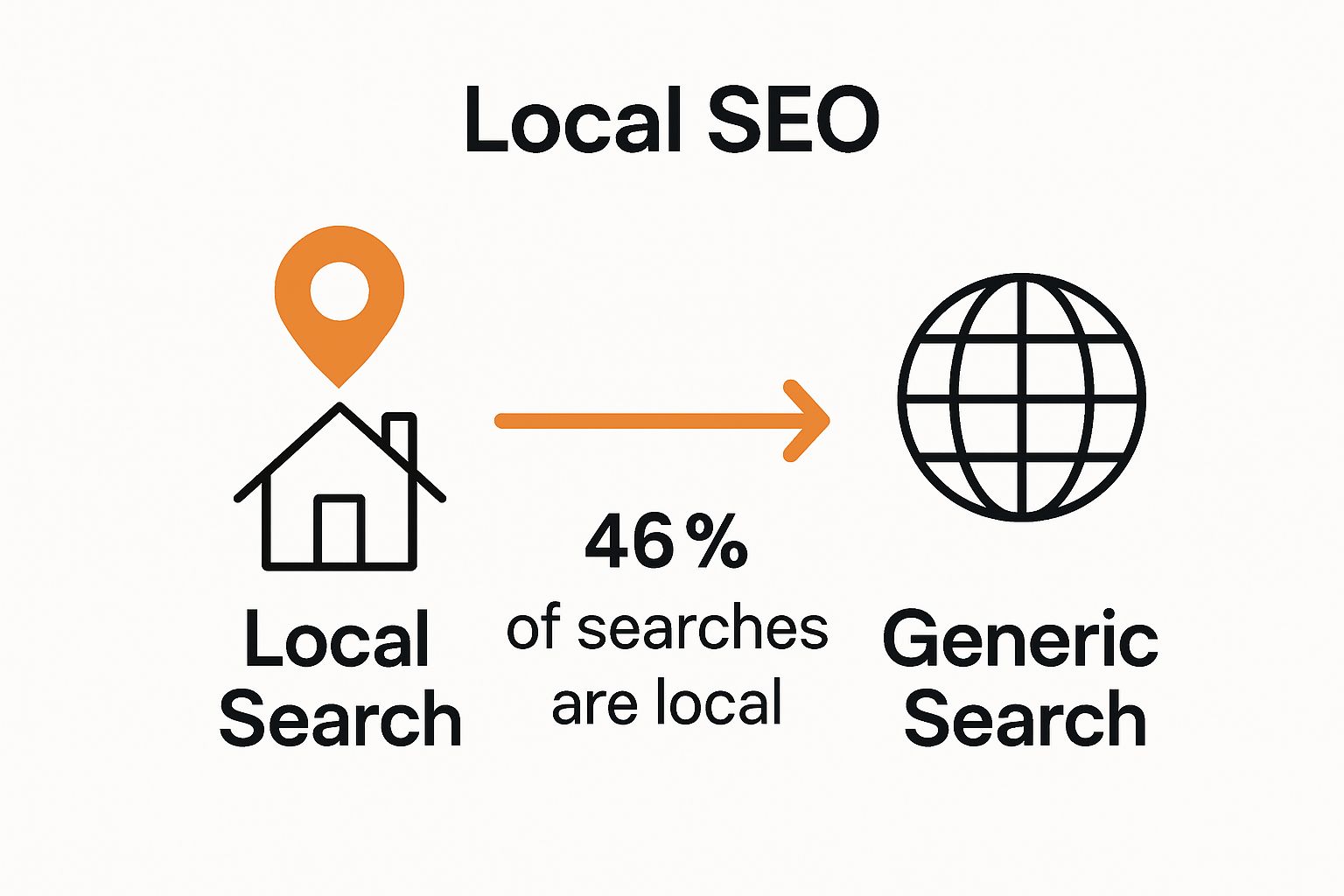- You are here:
- Home »
- real estate marketing
Tag Archives for " real estate marketing "

7 Innovative Real Estate Newsletter Ideas for Agents
Real estate newsletter ideas are packed with tips and data but not every agent knows how to make them truly irresistible. Most send out general updates that subscribers barely skim. Yet when you reveal that properties with virtual tours get 87 percent more views than standard listings, it shows how one simple change can captivate your audience and turn routine emails into something everyone wants to open.
Table of Contents
- Highlight Current Market Trends And Insights
- Share Case Studies And Success Stories
- Provide Tips For Home Buyers And Sellers
- Feature Local Community News And Events
- Offer Seasonal Maintenance And Home Improvement Advice
- Include Interactive Content Like Polls Or Surveys
- Showcase Properties With Virtual Tours And Listings
Quick Summary
| Takeaway | Explanation |
|---|---|
| Share local market insights | Provide specific data about trends and prices to position yourself as a knowledgeable expert. |
| Include authentic case studies | Highlight success stories that showcase your expertise and build trust with potential clients. |
| Offer actionable tips for clients | Provide targeted advice to help buyers and sellers make informed decisions throughout the real estate process. |
| Highlight community news and events | Showcase local happenings to engage readers and demonstrate your connection to the community. |
| Incorporate interactive content | Use polls and surveys to engage subscribers, gather insights, and foster client relationships. |
1: Highlight Current Market Trends and Insights
Your real estate newsletter can become a powerful communication tool when you consistently share market trends and insights. By transforming complex market data into digestible, engaging content, you position yourself as a knowledgeable local expert that clients trust.
Translating raw market statistics into compelling narratives helps your audience understand the broader real estate landscape. When potential buyers and sellers receive timely, accurate market information directly from you, they perceive added value beyond traditional transactional relationships.
Our local SEO guide suggests creating content that resonates with your specific community’s real estate interests. This means going beyond generic national trends and focusing on hyperlocal market dynamics.
Effective market trend newsletters typically include key insights such as:
- Average home sale prices in specific neighborhoods
- Days on market for different property types
- Median listing prices compared to previous quarters
- Inventory levels and what they mean for buyers and sellers
To make your newsletter truly compelling, contextualize these statistics. Explain what falling inventory might mean for first-time homebuyers or how increasing median prices impact investment strategies. According to National Association of Realtors research, providing interpretation alongside raw data significantly increases reader engagement.
Remember that transparency builds trust. Be honest about market challenges and opportunities. Clients appreciate agents who provide balanced, nuanced perspectives rather than overly optimistic or pessimistic narratives.
Professional real estate newsletters transform complex market data into stories that help clients make informed decisions. By consistently delivering valuable insights, you demonstrate expertise and build long-term relationships that extend far beyond individual transactions.
2: Share Case Studies and Success Stories for Real Estate Newsletter Ideas
Real estate newsletters become infinitely more compelling when they showcase authentic client success stories. These narratives transform abstract marketing materials into powerful, relatable experiences that potential clients can connect with emotionally.
Successful case studies demonstrate your professional expertise while humanizing your brand. They provide concrete evidence of your problem-solving skills and commitment to client satisfaction. Our local SEO guide recommends crafting stories that highlight unique challenges and innovative solutions.
According to Nielsen Norman Group research, narratives with specific details are 22 times more memorable than plain facts. When constructing your case studies, focus on elements that showcase your professional approach:
- Client background and initial real estate challenges
- Strategic approach you implemented
- Measurable outcomes and client satisfaction
Consider anonymizing client details to protect privacy while maintaining the story’s authenticity. Effective case studies might highlight scenarios like helping first-time homebuyers secure their dream property, assisting investors in finding profitable opportunities, or guiding sellers through complex market transitions.
Your success stories should demonstrate tangible value. Numbers and specific outcomes matter. Did you help a client sell their home 20% faster than the local average? Did you negotiate a purchase price significantly below market value? These concrete details transform generic narratives into powerful testimonials.
Additionally, varied case studies can appeal to different client segments. A mix of stories involving different property types, buyer demographics, and transaction complexities shows your versatility and comprehensive market understanding.
Ultimately, well-crafted case studies in your newsletter do more than showcase past achievements. They build trust, illustrate your professional capabilities, and provide potential clients with a clear vision of the exceptional service you provide.
3: Provide Real Estate Newsletter Ideas Tips for Home Buyers and Sellers
Transforming your real estate newsletter into a valuable resource means offering practical, actionable advice that helps clients navigate complex property transactions. By sharing targeted tips for both buyers and sellers, you establish yourself as a trusted advisor who goes beyond traditional transactional services.
Our real estate marketing guide emphasizes the importance of providing clear, strategic guidance that addresses common pain points in the real estate process.
According to National Association of Realtors research, clients value agents who provide comprehensive education about the buying and selling landscape. Your newsletter can become an essential tool for demystifying complex real estate processes.
For home buyers, consider including tips such as:
- Understanding mortgage pre-approval before house hunting
- Budgeting for hidden costs beyond the purchase price
- Importance of home inspections and what to look for
For sellers, focus on strategies that maximize property value and streamline the selling process:
- Cost-effective home improvement projects
- Staging techniques that attract potential buyers
- Pricing strategies aligned with current market conditions
The most effective tips blend practical advice with local market insights. Discuss how neighborhood-specific trends might impact buying or selling strategies. For instance, highlight upcoming infrastructure projects, school district changes, or emerging local development that could influence property values.
Remember that educational content builds trust. By consistently providing valuable information, you position yourself as a knowledgeable professional who genuinely wants to help clients make informed decisions. Your newsletter becomes more than a marketing tool – it transforms into a valuable resource clients will eagerly anticipate and share with their networks.
4: Feature Local Community News and Events
Highlighting local community news and events transforms your real estate newsletter from a marketing tool into a valuable neighborhood resource. By showcasing the vibrant local landscape, you demonstrate deep community connection and provide subscribers with engaging, relevant content.
Our neighborhood spotlights guide suggests creating content that goes beyond traditional real estate information. Local events and news create meaningful context for potential buyers and sellers understanding the true essence of a neighborhood.
According to Nextdoor’s Community Impact Report, 87% of residents are more likely to engage with local businesses that demonstrate genuine community involvement. Your newsletter can become a critical communication bridge between real estate services and local community dynamics.
Consider featuring content such as:
- Upcoming community festivals and cultural events
- Local infrastructure and development projects
- School district updates and educational initiatives
Effective community news coverage requires a strategic approach. Highlight events that showcase the neighborhood’s unique character. Are there new restaurants opening? Community improvement projects? Local business success stories? These narratives provide potential buyers with insights beyond property listings.
Remember to balance information with storytelling. Include personal perspectives, interview local business owners, or share community achievements. This approach transforms your newsletter from a transactional document into a compelling neighborhood narrative.
By consistently delivering rich, locally focused content, you position yourself as more than a real estate agent. You become a community connector, trusted advisor, and local expert who understands the intricate dynamics that make a neighborhood truly special.
5: Offer Seasonal Maintenance and Home Improvement Advice in Real Estate Newsletter Ideas
Providing seasonal maintenance and home improvement advice in your real estate newsletter positions you as a proactive, knowledgeable resource for current and potential clients. These practical tips demonstrate your commitment to helping homeowners protect and enhance their property investments.
Our real estate marketing guide emphasizes the importance of delivering actionable, timely information that adds genuine value to your clients’ lives.
According to HomeAdvisor’s State of Home Spending report, homeowners spend an average of $7,560 annually on home maintenance and improvement projects. Your newsletter can help them make informed, strategic decisions about these investments.
Consider offering advice tailored to different seasons:
- Summer preparation tips like air conditioning maintenance
- Winter weatherproofing strategies to prevent home damage
- Spring landscaping recommendations for curb appeal
Key maintenance advice should address both preventative care and value-adding improvements. This might include cost-effective projects that can increase home value, such as:
- Minor kitchen updates
- Energy-efficient upgrades
- Landscaping improvements
Your maintenance advice should blend practical guidance with potential financial benefits. Explain how regular maintenance can prevent costly repairs and how strategic improvements can boost property value. For instance, discuss how a $500 investment in fresh paint might yield a significant return during a future sale.
By consistently providing expert maintenance insights, you transform your newsletter from a marketing tool into a valuable homeowner resource. Clients will appreciate receiving timely, actionable advice that helps them protect and improve their most significant asset. This approach builds trust, positions you as an authority, and keeps your audience engaged beyond traditional real estate transactions.
6: Include Interactive Content Like Polls or Surveys
Interactive content transforms your real estate newsletter from a passive communication tool into an engaging, two-way conversation. Polls and surveys invite subscribers to actively participate, providing valuable insights while simultaneously increasing reader engagement and connection.
Our email marketing strategies guide highlights the critical role of interactive elements in maintaining subscriber interest and improving overall communication effectiveness.
According to HubSpot’s Marketing Research, interactive content generates 2x more conversions compared to passive content. By incorporating strategic polls and surveys, you create opportunities for meaningful client interactions.
Consider implementing interactive elements that provide mutual benefits:
- Market sentiment polls about local real estate trends
- Neighborhood preference surveys
- Home improvement idea collections
Effective interactive content should be:
- Concise and easy to complete
- Relevant to your audience’s interests
- Visually appealing
Designing compelling interactive content requires understanding your audience’s motivations. Ask questions that reveal client preferences, challenges, and aspirations. For instance, a survey about preferred home features can provide insights into market demands while making subscribers feel valued.
The data collected through these interactive elements serves multiple purposes. Beyond engagement, you gain actionable market intelligence that can inform your service offerings, marketing strategies, and client communication approaches.
By regularly featuring interactive content, you demonstrate that your newsletter is not just about broadcasting information, but about creating a collaborative, responsive community where client perspectives are genuinely heard and respected.
7: Showcase Properties with Virtual Tours and Listings
Virtual tours and property listings have revolutionized how real estate agents present properties in their newsletters. Digital showcasing allows potential buyers to explore homes remotely, providing an immersive experience that traditional photography cannot match.
Our virtual tours guide emphasizes creating engaging, high-quality digital property presentations that capture potential buyers’ imaginations.
According to Matterport’s Real Estate Visualization Report, properties with virtual tours receive 87% more views compared to traditional listings, dramatically increasing potential buyer engagement.
When incorporating property showcases in your newsletter, consider these strategic approaches:
- High-resolution property images
- 360-degree virtual tour links
- Detailed property description highlighting unique features
Key elements that make property listings compelling include:
- Clear, professional photography
- Accurate, concise property descriptions
- Transparent pricing information
Digital property presentation requires more than just uploading images. Craft narratives that help potential buyers visualize living in the space. Describe not just the physical attributes, but the lifestyle each property offers. A modern kitchen isn’t just about appliances – it’s about family gatherings, culinary adventures, and creating memories.
Technology has transformed property marketing. By integrating sophisticated virtual tour technologies and thoughtful storytelling, your newsletter becomes a powerful tool that doesn’t just show properties, but sells compelling living experiences. Your goal is to help subscribers imagine themselves walking through these spaces, turning passive viewing into active interest.
Below is a comprehensive table summarizing the seven innovative real estate newsletter ideas for agents, including their key focus, main benefits, and practical implementation tips.
| Newsletter Idea | Key Focus | Main Benefit | Practical Example/Tip |
|---|---|---|---|
| Highlight Market Trends and Insights | Share neighborhood-specific data and analysis | Establish authority, build trust | Explain what statistics mean for buyers/sellers |
| Share Case Studies and Success Stories | Feature authentic client journeys and outcomes | Build credibility and emotional connection | Include measurable results and detailed narratives |
| Provide Tips for Home Buyers and Sellers | Offer actionable advice and local market strategies | Empower clients to make informed decisions | Give seasonal tips, explain processes for buyers and sellers |
| Feature Local Community News and Events | Cover events, development, and neighborhood updates | Engage audience; show community expertise | Highlight festivals, infrastructure projects, and spotlights |
| Offer Seasonal Maintenance and Improvement Advice | Advise on timely home care and value-boosting upgrades | Demonstrate proactivity, foster long-term relationships | Suggest cost-effective projects for different seasons |
| Include Interactive Content like Polls or Surveys | Engage readers with polls and gather feedback | Increase engagement, gain market insights | Ask about market sentiment or home feature preferences |
| Showcase Properties with Virtual Tours and Listings | Present listings using immersive digital experiences | Capture interest, increase views, stand out | Use 360-degree tours, quality images, lifestyle-focused descriptions |
Ready to Transform Your Real Estate Newsletter Ideas Into Game-Changing Marketing Tools?
Standing out in your local market is tough when every agent is fighting for attention. Does your newsletter truly offer value beyond basic listings? If you recognize yourself struggling to deliver market trends, engaging case studies or actionable homeowner tips as outlined in our article, it is time to level up. Imagine sending emails packed with hyperlocal insights, strong storytelling and expert-driven tips—making your brand the resource that buyers and sellers trust and remember. See how our real estate marketing strategies can help your content resonate with the local audience you want to reach.

Stop your email marketing from blending into the crowd. Let Content Charlie craft SEO-smart, trust-building newsletters and digital content that set you apart as the local expert. Visit Content Charlie now for proven solutions designed specifically for real estate. Book your free consult today—you deserve newsletters that get read, shared and drive results.
Frequently Asked Questions
How can I highlight current market trends in my real estate newsletter?
To highlight current market trends, focus on local statistics like average home sale prices and inventory levels. Break down these numbers in simple terms and explain their implications for buyers and sellers in your community.
What type of client success stories should I include in my newsletter?
Include diverse client success stories that demonstrate your problem-solving skills and professional expertise. Showcase detailed narratives about unique challenges you faced and the measurable outcomes of your efforts to resonate with potential clients.
What practical tips should I share for home buyers in my newsletter?
For home buyers, share actionable tips such as understanding mortgage pre-approval processes and budgeting for hidden costs. Provide information that helps them feel informed and prepared for their purchasing journey.
How can I feature local community news effectively in my newsletter?
Feature local community news by including updates on upcoming events and developments that highlight the neighborhood’s appeal. Focus on stories that connect potential buyers to the community, showcasing its character and unique features.
What seasonal maintenance tips can I offer to homeowners in my newsletter?
Offer seasonal maintenance tips that guide homeowners on tasks such as weatherproofing in winter or landscaping in spring. Provide clear, actionable steps that help them maintain their property and enhance its value over time.
How can I incorporate interactive content like polls in my real estate newsletter?
Incorporate polls by creating simple, relevant questions related to your audience’s interests, such as market trends or home preferences. This invites engagement and provides you with valuable insights from your subscribers.
Recommended
- email marketing tactics Archives – Content Charlie
- real estate email marketing Archives – Content Charlie
- real estate emails Archives – Content Charlie
- email marketing strategies Archives – Content Charlie
- SEO for Real Estate Agencies: Simple Strategies to Grow Your Business
- Why Use Independent Real Estate Agent for Luxury Homes – ULI & LISA Mallorca Property Blog

Understanding Why Blogging Boosts SEO for Real Estate
SEO can feel overwhelming for real estate agents who want their websites to attract real clients. Most believe you have to master every algorithm and tech trick out there. We need to understand why blogging boosts seo.
Yet the surprising truth is that consistent blogging alone can make your website up to 4 times more effective at reaching qualified leads. That flips the script on what really drives online success.
Table of Contents
- The Basics Of Seo And Blogging
- How Blogging Improves Website Authority
- The Role Of Keywords And Content Strategy
- Engagement And Audience Connection Through Blogging
- Long-Term Benefits Of Consistent Blogging
Quick Summary
| Takeaway | Explanation |
|---|---|
| Create relevant content consistently | Regularly publishing blogs increases website visibility and attracts qualified leads. |
| Focus on strategic keyword integration | Use long-tail keywords tailored to specific client needs to enhance searchability. |
| Build website authority through quality | High-quality, informative content establishes trust and credibility with search engines and clients. |
| Engage with your audience genuinely | Personal insights and addressing client concerns help build a loyal readership and community trust. |
| Invest in long-term blogging | A consistent blogging strategy creates lasting digital resources that continue to attract traffic over time. |
The Basics of SEO and Blogging
Search Engine Optimization (SEO) represents a strategic approach that helps websites become more visible and attractive to search engines like Google.
For real estate professionals, blogging serves as a powerful mechanism to enhance online presence and attract potential clients through targeted content.
Google’s search documentation emphasizes that quality content helps search engines discover, crawl, and understand website information effectively.
Understanding SEO Fundamentals
At its core, SEO involves optimizing digital content to rank higher in search engine results pages (SERPs). For real estate agents, this means creating content that answers potential clients’ questions about property markets, neighborhoods, buying strategies, and local real estate trends.
The goal is not just attracting website visitors but drawing qualified leads who are genuinely interested in real estate services.
How Blogging Supports SEO Strategy
Blogs provide multiple advantages for SEO performance. They allow real estate professionals to:
- Generate fresh, relevant content consistently
- Target specific keywords related to local property markets
- Demonstrate professional expertise and market knowledge
- Create opportunities for internal and external linking
By publishing regular, high-quality content that addresses client interests and local real estate dynamics, agents can signal to search engines that their website is an authoritative and valuable resource. Learn more about content marketing strategies that can elevate your real estate business’s online visibility.
Successful SEO through blogging requires understanding audience needs, researching relevant keywords, and delivering informative content that provides genuine value to potential property buyers and sellers.
How Blogging Improves Website Authority
Website authority represents a critical metric determining how search engines perceive the credibility and relevance of a digital platform.
For real estate professionals, building this authority through strategic blogging can significantly enhance online visibility and attract potential clients. Moz’s Domain Authority research highlights that websites with consistent, high-quality content tend to rank higher in search engine results.
The Role of Content Quality and Consistency
Blogs serve as a powerful mechanism for establishing expertise and trustworthiness in the real estate market. By producing informative, original content that addresses specific client questions and concerns, agents can demonstrate deep understanding of local property landscapes.
Consistent publishing signals to search engines that a website is active, relevant, and committed to providing valuable insights.
Building Credibility Through Strategic Content
Website authority is not just about quantity but the strategic depth of content. Real estate professionals can enhance their digital credibility by:
- Creating in-depth neighborhood guides
- Analyzing local market trends
- Sharing expert insights on property investment
- Addressing common client questions and challenges
These approaches transform a blog from a simple webpage into a comprehensive resource that search engines recognize as authoritative.
Explore strategies for boosting Google rankings to further understand how strategic content can elevate your online presence.
By consistently delivering valuable, targeted content, real estate agents can systematically build website authority that attracts both search engine algorithms and potential clients seeking genuine expertise.
To clarify how strategic blogging impacts website authority in real estate, the table below breaks down the key characteristics of quality content versus consistency and explains how each contributes to higher search engine rankings.
| Characteristic | Impact on SEO | How It Builds Authority |
|---|---|---|
| Content Quality | Elevates site in search rankings | Signals expertise and trustworthiness |
| Content Consistency | Encourages regular site crawling by search engines | Shows site is active and relevant |
| In-depth Market Analysis | Targets client needs and search intent | Demonstrates knowledge of local trends |
| Addressing Client Questions | Attracts targeted traffic | Builds reputation as a resource |
| Originality | Reduces competition with duplicate content | Distinguishes the agent |
| s voice |

The Role of Keywords and Content Strategy
Keywords represent the critical bridge connecting potential real estate clients with relevant online content.
Developing a sophisticated content strategy that integrates targeted keywords naturally can transform a blog from a simple collection of posts into a powerful lead generation tool.
Moz’s SEO guide emphasizes that strategic keyword selection enables websites to appear precisely where potential clients are searching.
Understanding Keyword Relevance in Real Estate
For real estate professionals, keyword strategy goes beyond generic terms like “houses for sale.” Successful content marketing requires understanding the nuanced search behaviors of local property seekers.
This means identifying long-tail keywords that reflect specific client intentions, such as “three-bedroom homes in Brisbane waterfront” or “investment properties near Gold Coast beaches.”
Crafting a Strategic Content Approach
Effective keyword integration demands a comprehensive approach that considers multiple factors:
- Identifying local search patterns
- Matching keywords with specific client needs
- Creating content that genuinely answers user questions
- Balancing keyword density with natural, engaging writing
Real estate agents must think beyond simple keyword placement and focus on developing content that provides genuine value and directly addresses potential client queries. Learn more about content marketing strategies that can help refine your approach to digital visibility.
By understanding and implementing a sophisticated keyword strategy, real estate professionals can create content that not only ranks well in search results but also meaningfully connects with potential buyers and sellers seeking expert guidance.
Engagement and Audience Connection Through Blogging
Blogging transcends traditional marketing by creating meaningful connections between real estate professionals and potential clients. Authentic, valuable content transforms a website from a mere digital brochure into an interactive platform for community engagement.
Sprout Social’s research on social media engagement highlights how consistent, relevant content encourages deeper audience interactions.
Building Trust Through Personalized Content
Successful real estate blogs go beyond property listings by sharing insights that demonstrate genuine understanding of client needs. This approach involves crafting narratives that speak directly to potential buyers’ and sellers’ challenges, fears, and aspirations.
By addressing specific local market nuances, real estate agents can position themselves as trusted neighborhood experts rather than simply transactional service providers.
Strategies for Meaningful Audience Interaction
Engagement requires a multifaceted approach that encourages reader participation and builds community trust:
- Creating content that answers specific client questions
- Sharing personal insights about local neighborhood developments
- Providing actionable advice for property investors
- Responding promptly to comments and reader inquiries
Learn more about building writing connections to enhance your digital communication strategy. Real estate professionals who consistently deliver value through their blogs can transform casual website visitors into loyal followers and potential long-term clients, ultimately driving both SEO performance and business growth.
This table summarizes various approaches real estate professionals can use to foster engagement and build audience connection through blogging, highlighting the focus of each strategy and the main benefit it delivers.
| Engagement Strategy | Focus | Main Benefit |
|---|---|---|
| Answering Client Questions | Addressing specific local concerns | Builds trust and authority |
| Sharing Neighborhood Insights | Providing personal perspectives | Demonstrates local expertise |
| Offering Actionable Advice | Giving investment or buying tips | Positions agent as a problem-solver |
| Responding to Comments/Inquiries | Interactive communication | Encourages repeat visits and loyalty |
| Sharing Market Developments | Real-time updates and market trends | Keeps content fresh and relevant |
Long-Term Benefits of Consistent Blogging
Consistent blogging represents a strategic investment in digital marketing that compounds value over time for real estate professionals.
Unlike traditional advertising that provides temporary visibility, blog content creates a lasting digital footprint that continually attracts potential clients.
HubSpot research demonstrates that companies prioritizing blogging experience significantly higher return on investment through sustained web traffic and lead generation.
Compounding Content Value
Each blog post functions as a permanent asset in a real estate agent’s digital portfolio.
 Evergreen content addressing timeless topics like first-time homebuyer guidance, neighborhood insights, or investment strategies continues generating organic traffic months and even years after initial publication.
Evergreen content addressing timeless topics like first-time homebuyer guidance, neighborhood insights, or investment strategies continues generating organic traffic months and even years after initial publication.
This approach transforms blogs from ephemeral marketing materials into enduring resources that consistently showcase professional expertise.
Strategic Long-Term Positioning
Consistent blogging offers multiple strategic advantages for real estate professionals:
- Building a comprehensive digital knowledge base
- Establishing credibility as a local market expert
- Creating searchable content that attracts targeted leads
- Developing a repository of shareable professional insights
Explore strategies for professional branding to understand how consistent content creation elevates your digital presence.
By treating blogging as a long-term commitment rather than a sporadic marketing tactic, real estate agents can systematically build an authoritative online platform that attracts and retains potential client interest.
Ready to See Your Real Estate Brand Rise Above the Competition?
Feeling frustrated because your blog posts are not attracting serious home buyers or sellers? You invest time creating content but struggle to stand out in suburb-level searches.
As this article explains, consistent, SEO-focused blogging builds website authority, fuels Google rankings, and keeps your audience coming back for up-to-date real estate insights.
But crafting this kind of content takes expertise, strategy, and a deep understanding of what local clients are searching for.

At Content Charlie, we transform your real estate marketing with copywriting that gets you found by your ideal clients. Discover how our proven content marketing strategies and focus on local SEO turn your blog into a powerful lead magnet. Stop letting your competitors win those clicks. Reach out now to start building trust, capturing suburb searches, and growing your authority in every neighborhood you serve. Visit Content Charlie today and make your next move the one that dominates your market.
Frequently Asked Questions
How does blogging improve SEO for real estate websites?
Blogging improves SEO for real estate websites by generating fresh, relevant content that search engines prioritize. To enhance your SEO, publish at least one high-quality blog post each week that addresses local market trends or client questions.
What types of content should real estate blogs include to boost SEO?
Real estate blogs should include in-depth neighborhood guides, market analyses, and expert insights to engage potential clients. Aim to create content that directly addresses common client concerns, ensuring each piece has targeted keywords relevant to your audience.
How often should I publish blog posts to see SEO results?
To see noticeable improvements in SEO, aim to publish blog posts consistently, ideally once a week or every two weeks. Regular updates signal to search engines that your site is active, which can lead to higher rankings.
What are long-tail keywords, and why are they important for real estate blogging?
Long-tail keywords are specific phrases that potential clients use when searching online, like “investment properties near beaches.” Integrate these into your blog content to attract highly targeted traffic and meet the specific needs of your audience.
How can I measure the impact of my blogging on SEO performance?
You can measure the impact of blogging on SEO performance through metrics like organic traffic, keyword rankings, and engagement rates. Track these metrics monthly to evaluate the effectiveness of your blog content and adjust your strategy accordingly.
What actions can I take to ensure my blog content is valuable to clients?
To ensure your blog content is valuable, focus on addressing client questions and providing solutions based on local market insights. Engage with your audience by inviting comments and responding promptly to create a sense of community.
Recommended
- real estate marketing Archives – Content Charlie
- real estate SEO Archives – Content Charlie
- social media tips for real estate Archives – Content Charlie
- real estate social media strategy Archives – Content Charlie
- SEO for Real Estate Agencies: Simple Strategies to Grow Your Business
- Understanding SEO Best Practices for Your Business – My Blog

Understanding Real Estate SEO Metrics Explained
Real estate agents used to rely mostly on personal networks and open houses to woo buyers. Now everything happens online and a staggering 97 percent of home buyers start their search on the internet. Most people think it all comes down to having a flashy website or posting listings every day. But it turns out the real secret is hiding in your SEO metrics and these numbers can reveal exactly how to win the digital battle for new clients.
Table of Contents
- What Are Real Estate SEO Metrics?
- Why Real Estate SEO Metrics Matter For Agents
- Key Components Of Real Estate SEO Metrics
- How Real Estate SEO Metrics Inform Online Strategies
Quick Summary
| Takeaway | Explanation |
|---|---|
| Real estate SEO metrics enhance visibility | Measuring these metrics helps agents improve their online presence and attract more potential clients. |
| Track organic search rankings for success | Keeping an eye on search rankings for keywords is essential to ensure effective property listing visibility. |
| Focus on high-performing content | Identify which content attracts the most clients to optimize future marketing strategies. |
| Analyze geographical search behavior | Understanding where clients search helps tailor marketing efforts to specific locations effectively. |
| Allocate resources to top channels | Direct marketing budgets toward effective strategies based on performance data to maximize return on investment. |
What Are Real Estate SEO Metrics?
Real estate SEO metrics are quantitative measurements that help agents and marketers understand how their online content performs in search engine rankings and digital visibility. These specialized metrics go beyond traditional website analytics by providing targeted insights specific to real estate digital marketing strategies.
Understanding Core SEO Performance Indicators
At their fundamental level, real estate SEO metrics track how effectively your digital content attracts potential property buyers and sellers through search engines. Explore our guide on local SEO for real estate to understand the broader context of these performance indicators.
Key performance indicators in real estate SEO typically include:
- Organic Search Rankings: Your website’s position for specific property-related keywords
- Website Traffic Volume: Number of visitors arriving through search engines
- Click Through Rate (CTR): Percentage of searchers who click on your website link
- Bounce Rate: Percentage of visitors who leave your site quickly after arriving
Why Real Estate SEO Metrics Matter
Measuring these metrics provides critical intelligence about your digital marketing strategy. Moz’s SEO research demonstrates that understanding these metrics helps real estate professionals optimize their online presence and attract more potential clients.
By tracking these metrics, real estate agents can:
- Identify which content attracts the most potential clients
- Understand geographical search behavior
- Optimize website content for better search engine performance
- Make data driven decisions about digital marketing investments
Successful real estate professionals recognize that SEO metrics are not just numbers but strategic tools that illuminate the path to digital marketing excellence. They transform raw data into actionable insights that can significantly improve online visibility and client acquisition strategies.
Why Real Estate SEO Metrics Matter for Agents
Real estate SEO metrics transform raw data into strategic insights, enabling agents to navigate the complex digital landscape of property marketing with precision and effectiveness. Learn about our SEO strategies for real estate agents to understand how these metrics drive business growth.
Digital Visibility and Competitive Advantage
In a market where online presence determines client acquisition, SEO metrics provide agents with critical competitive intelligence. National Association of Realtors research reveals that over 97% of home buyers now use online resources during their property search, making digital visibility crucial.
Key competitive advantages of tracking SEO metrics include:
- Targeted Marketing: Understanding which keywords attract potential clients
- Performance Tracking: Measuring the effectiveness of digital marketing strategies
- Client Acquisition Optimization: Identifying most successful content and search channels
- Resource Allocation: Directing marketing investments toward high-performing strategies
Financial Impact and Business Growth
SEO metrics are not just technical measurements but direct indicators of potential revenue. By analyzing these metrics, real estate agents can:
- Reduce marketing expenditure by focusing on proven effective channels
- Increase conversion rates through targeted content strategy
- Build a robust online reputation that attracts high-quality leads
- Understand local market search behaviors and preferences
Successful real estate professionals recognize that SEO metrics provide more than analytics. They offer a roadmap for digital marketing success, transforming complex data into actionable strategies that drive business growth and client engagement.

Key Components of Real Estate SEO Metrics
Real estate SEO metrics encompass a complex ecosystem of performance indicators that provide comprehensive insights into digital marketing effectiveness. Learn more about our real estate SEO strategies to understand how these components work together.
Fundamental Performance Indicators
Organic search metrics form the foundation of real estate digital marketing analysis. Ahrefs SEO research highlights that these indicators reveal critical information about website visibility and user engagement.
Key fundamental performance indicators include:

- Search Rankings: Position of property listings and content in search results
- Organic Traffic: Number of visitors arriving through search engines
- Click Through Rate (CTR): Percentage of searchers clicking on your website links
- Bounce Rate: Proportion of visitors leaving your site quickly
Advanced Analytical Components
Beyond basic metrics, sophisticated real estate SEO analysis requires deeper examination of user behavior and content performance. Advanced metrics help agents understand not just how many people visit their site, but how effectively those visits translate into potential client interactions.
Critical advanced metrics encompass:
- Conversion Rate: Percentage of website visitors who take desired actions
- Time on Site: Average duration visitors spend exploring property content
- Geographical Search Data: Understanding location based search patterns
- Mobile Performance: Website effectiveness across different device types
Successful real estate professionals recognize that these metrics are interconnected signals that provide a holistic view of digital marketing performance. By comprehensively analyzing these components, agents can develop targeted strategies that improve online visibility, attract qualified leads, and ultimately drive business growth.
To clarify the fundamental and advanced metrics used in real estate SEO, the following table summarizes each key component and its purpose.
| SEO Metric | Description |
|---|---|
| Organic Search Rankings | Position your website holds for property-related keywords |
| Website Traffic Volume | Number of visitors arriving via search engines |
| Click Through Rate (CTR) | Percentage of searchers who click on your website link |
| Bounce Rate | Percentage of visitors who leave quickly after arriving |
| Conversion Rate | Percentage of visitors taking a desired action |
| Time on Site | Average duration visitors spend exploring property content |
| Geographical Search Data | Information about where website traffic originates |
| Mobile Performance | Effectiveness of the website across different device types |
How Real Estate SEO Metrics Inform Online Strategies
Real estate SEO metrics transform raw data into strategic roadmaps for digital marketing success, enabling agents to make precision driven decisions about their online presence. Explore our guide to enhancing real estate online strategies to understand how metrics drive strategic planning.
Strategic Content Development
Content optimization emerges as a critical outcome of comprehensive SEO metric analysis. Google Search Central emphasizes that understanding user behavior through metrics allows agents to create more targeted, relevant content that resonates with potential clients.
Key strategic content development insights include:
- Identifying most engaging property topics
- Understanding user search intent
- Determining optimal content length and format
- Recognizing geographical search preferences
Targeted Marketing Resource Allocation
SEO metrics provide a sophisticated framework for intelligent marketing resource allocation. By analyzing performance data, real estate professionals can:
- Prioritize high performing marketing channels
- Redirect budget from underperforming strategies
- Develop hyper targeted audience segments
- Create personalized content experiences
Successful digital marketing in real estate requires continuous adaptation. SEO metrics offer real time feedback, allowing agents to pivot strategies quickly, ensuring their online presence remains dynamic, responsive, and aligned with evolving market demands and client expectations.
Ready to Turn Real Estate SEO Metrics Into Measurable Results?
Are you feeling overwhelmed by raw numbers and complex metrics, but hungry for real progress in your property marketing? The article explained how real estate SEO metrics reveal where your website attracts buyers and sellers, which content truly engages your local market, and how you can make smarter marketing decisions that move the needle.

At Content Charlie, we transform insights into action. Let us help you capture suburb-level searches and convert traffic into ready-to-act clients. Discover how our SEO-driven copywriting and tailored local strategies boost your digital visibility and generate leads that count.
Stop guessing and start growing. Visit Content Charlie now and see how better metrics lead to real results for your real estate business.
Frequently Asked Questions
What are the key real estate SEO metrics I should track?
To optimize your online presence, focus on key real estate SEO metrics such as organic search rankings, website traffic volume, click-through rate (CTR), and bounce rate. Start by monitoring these metrics regularly to gain insights into your digital marketing performance and identify areas for improvement.
How can I improve my website’s organic search rankings?
To enhance your organic search rankings, optimize your website content by incorporating relevant property keywords, improving page load speed, and ensuring mobile responsiveness. Regularly update your content and track changes over a 30–60 day period to gauge the impact of your efforts.
What role do SEO metrics play in client acquisition for real estate agents?
SEO metrics are essential for client acquisition as they help identify which content attracts potential clients and the effectiveness of your marketing strategies. Analyze data on visitor behavior and adjust your content to improve engagement and conversion rates.
How can I leverage geographical search data to improve my real estate SEO strategy?
To use geographical search data effectively, analyze where your website traffic comes from and tailor your content to local market interests. Implement targeted local keyword strategies and update your content based on findings to enhance local search visibility.
What actions can I take if my bounce rate is high?
If your bounce rate is high, focus on improving user experience by optimizing website loading times and providing engaging, relevant content that meets visitor expectations. Consider conducting an analysis of your top landing pages and making adjustments to encourage longer site engagement and lower the bounce rate.
Recommended
- real estate SEO Archives – Content Charlie
- SEO for realtors Archives – Content Charlie
- local SEO for real estate Archives – Content Charlie
- real estate agent visibility Archives – Content Charlie

Understanding Why Local SEO Matters for Real Estate
Local SEO is changing the way home buyers and sellers connect with real estate agents in their own neighborhoods. And get this. 46% of all Google searches now have local intent, which means nearly half of online house-hunters are searching for answers right where they live. Most agents still focus only on broad search terms, but the agents who win clients today are the ones who master hyperlocal visibility and become the top choice just down the street.
Table of Contents
- Defining Local Seo And Its Importance In Real Estate
- The Impact Of Local Search On Consumer Behavior
- How Local Seo Enhances Online Visibility For Agents
- Key Components Of Effective Local Seo Strategies
- Real-World Examples Of Local Seo Success In Real Estate
Quick Summary
| Takeaway | Explanation |
|---|---|
| Optimize Your Google Business Profile | Ensure your profile has accurate information to improve local visibility. |
| Focus on Hyperlocal Content Creation | Develop content tailored to specific neighborhoods to engage local clients effectively. |
| Leverage Online Reviews for Credibility | Encourage clients to leave positive reviews to build trust in your services. |
| Use Location-Specific Keywords | Incorporate local keywords to enhance search rankings in targeted areas. |
| Maintain Consistency Across Platforms | Keep business information uniform on all online platforms to boost local SEO success. |
Defining Local SEO and Its Importance in Real Estate
Local SEO represents a strategic digital marketing approach specifically designed to help businesses increase their visibility in geographically targeted search results. For real estate professionals, this means optimizing online presence to attract potential clients within specific neighborhoods, suburbs, or regional areas.
What Exactly is Local SEO?
Local SEO goes beyond traditional search engine optimization by focusing on location-specific search signals. In real estate, this translates to helping potential buyers and sellers find your services when searching for property-related information in their immediate geographic area. Local SEO for real estate involves multiple tactics designed to improve your visibility in local search results.
Key components of local SEO for real estate include:
- Optimizing Google Business Profile with accurate business information
- Creating location-specific content targeting particular suburbs or neighborhoods
- Building local citations and consistent business information across online platforms
- Generating location-based reviews from satisfied clients
Why Local SEO Matters for Real Estate Professionals
According to Google’s Local Search Ranking Factors Study, 46% of all Google searches have local intent, making local SEO critical for real estate agents seeking to capture targeted leads. By implementing strategic local SEO practices, agents can significantly improve their chances of appearing in “near me” searches and map pack results.
For real estate professionals, local SEO is not just about ranking higher in search results. It’s about establishing credibility, demonstrating local expertise, and connecting with potential clients who are actively searching for property services in specific areas. By focusing on hyperlocal optimization strategies, agents can differentiate themselves from competitors and become the go-to real estate expert in their target market.

The Impact of Local Search on Consumer Behavior
Local search has fundamentally transformed how consumers discover, evaluate, and interact with businesses, particularly in service-oriented industries like real estate. The digital landscape has shifted consumer expectations, making immediate, geographically relevant information a critical factor in decision-making processes.
Understanding Consumer Search Patterns
Modern consumers have become increasingly sophisticated in their search behaviors, preferring hyper-targeted results that provide precise, localized information. In real estate, this means potential buyers and sellers are not just searching for generic property listings, but seeking agents, market insights, and property details specific to their immediate neighborhood or suburb.
Key characteristics of local search consumer behavior include:
- Preference for immediate, location-specific results
- High reliance on mobile devices for quick information retrieval
- Strong emphasis on user-generated content and local reviews
- Expectation of personalized, contextually relevant search experiences
Trust and Credibility in Local Searches
According to research from the National Association of Realtors, 97% of homebuyers use the internet during their property search, demonstrating the profound impact of digital platforms on real estate consumer behavior. Local search results play a crucial role in establishing trust and credibility.
Consumers view businesses with strong local search presence as more legitimate and trustworthy. For real estate professionals, this means that appearing in local search results is not just about visibility, but about creating a perception of local expertise and reliability. By consistently delivering accurate, location-specific information, agents can build digital credibility that translates into real-world client relationships.
The evolution of local search has fundamentally reshaped how consumers make purchasing decisions, turning geographical relevance into a key differentiator in competitive markets like real estate.
This table highlights research-backed statistics and their implications for local SEO and real estate agents, helping illustrate the importance and impact of local search strategies.
| Statistic | Source | Significance for Real Estate Agents |
|---|---|---|
| 46% of Google searches have local intent | BrightLocal, Moz | Indicates nearly half of searchers want local information. |
| 97% of homebuyers use the internet to search | National Association of Realtors | Confirms the digital-first behavior of today’s clients. |
| 44% of local pack results get click-throughs | Moz | Highlights the value of optimizing for Google’s local map pack. |
| 87% of consumers read reviews for local business | BrightLocal | Underscores the role of reviews in consumer trust decisions. |
How Local SEO Enhances Online Visibility for Agents
Local SEO serves as a powerful digital strategy that transforms how real estate professionals attract and engage potential clients in an increasingly competitive online marketplace. By strategically optimizing digital presence, agents can significantly amplify their visibility and reach within specific geographic territories.
Strategic Digital Positioning
Effective local SEO enables real estate agents to position themselves precisely where potential clients are searching. This means appearing prominently in local search results, map listings, and location-based queries that directly target individuals seeking property services in specific suburbs or neighborhoods.
Key strategic advantages of local SEO for real estate agents include:
- Targeting hyperlocal search queries with precision
- Increasing organic visibility in geographic-specific searches
- Building credibility through location-based content and reviews
- Competing effectively against larger real estate agencies
Maximizing Digital Real Estate
Real estate agent visibility depends on understanding and leveraging digital platforms strategically. According to Moz’s Local Search Ranking Factors, Google’s local pack results receive approximately 44% of all click-through traffic, making local SEO optimization crucial for capturing potential client attention.
Successful local SEO implementation goes beyond simple keyword optimization. It requires a comprehensive approach that includes consistent business information across online platforms, generating location-specific content, managing online reviews, and creating a robust Google Business Profile that accurately represents an agent’s local expertise and service areas.
By mastering local SEO techniques, real estate professionals can transform their digital presence from passive online listings to dynamic, engaging platforms that actively attract and convert potential clients in their target markets.

Key Components of Effective Local SEO Strategies
Local SEO demands a multifaceted approach that goes beyond simple keyword optimization. Real estate professionals must develop a comprehensive strategy that integrates multiple digital marketing elements to establish strong local online presence and credibility.
Foundational Local SEO Elements
Successful local SEO strategies for real estate agents require precise, strategic implementation across multiple digital platforms. This means creating a cohesive online ecosystem that signals local expertise and geographic relevance to both search engines and potential clients.
Critical foundational elements include:
- Consistent business name, address, and phone number across all online platforms
- Comprehensive and accurate Google Business Profile optimization
- Location-specific website content highlighting neighborhood expertise
- Strategic use of local keywords reflecting specific suburban markets
Technical and Content Optimization
Local real estate marketing requires careful attention to technical details and content quality. According to Ahrefs’ Local SEO Guide, successful strategies integrate precise technical optimization with high-quality, location-specific content that demonstrates deep understanding of local property markets.
Real estate professionals must focus on creating rich, informative content that addresses specific local market conditions, neighborhood insights, and hyperlocal property trends. This approach not only improves search engine rankings but also establishes the agent as a trusted local expert who understands the nuanced dynamics of specific geographic areas.
By implementing a holistic local SEO strategy, real estate agents can transform their digital presence from generic online listings to powerful, targeted marketing platforms that directly connect with potential clients in their specific service areas.
To clarify the foundational elements and technical strategies essential for effective local SEO in real estate, the table below breaks down the core components and their descriptions.
| Local SEO Component | Description |
|---|---|
| Consistent Business Information | Ensure name, address, and phone number are the same across all online platforms. |
| Google Business Profile Optimization | Keep your Google Business Profile accurate and complete to enhance local search visibility. |
| Location-Specific Website Content | Develop content focused on specific neighborhoods or suburbs to demonstrate local expertise. |
| Strategic Use of Local Keywords | Incorporate geographic keywords relevant to your service area for better targeted search results. |
| High-Quality Local Content | Publish in-depth, informative articles reflecting local market conditions and trends. |
| Online Review Management | Actively generate and manage reviews from local clients to build trust and authority. |
Real-World Examples of Local SEO Success in Real Estate
Local SEO represents more than a theoretical concept for real estate professionals. It is a practical strategy that can dramatically transform digital marketing effectiveness, enabling agents to capture targeted leads and establish neighborhood expertise through strategic online positioning.
Hyperlocal Content Strategies
Successful local SEO implementation requires agents to develop content that speaks directly to specific community needs and interests. This means creating detailed, location-specific resources that demonstrate deep understanding of particular suburbs, market trends, and neighborhood dynamics.
Key characteristics of successful hyperlocal content include:
- Detailed neighborhood guides with insider perspectives
- Market analysis specific to individual suburbs or districts
- Local market trend reports with current property insights
- Localized case studies highlighting recent property transactions
Measurable Impact and Conversion Potential
Location-based hashtags can play a significant role in amplifying local visibility. According to BrightLocal’s Local Consumer Review Survey, 87% of consumers read online reviews for local businesses in 2022, underscoring the critical importance of generating localized, trustworthy digital content.
Real estate agents who successfully implement local SEO strategies can experience remarkable outcomes. By developing targeted content that addresses specific community needs, agents transform their digital presence from generic listings to powerful, hyper-relevant marketing platforms that directly connect with potential clients in their precise service areas.
Through strategic local SEO approaches, real estate professionals can effectively differentiate themselves in competitive markets, demonstrating not just property expertise, but genuine community understanding and connection.
Take Control of Local Search and Become the Go-To Real Estate Expert
Are you struggling to stand out in your local market? The article made it clear: real estate clients are looking for agents who not only show up in suburb-level searches but also demonstrate true neighborhood expertise. With buyers relying on hyperlocal searches and online reviews, missing out on local SEO for real estate means leaving valuable opportunities on the table. It is time to stop feeling invisible or overwhelmed by the competition. Let the pain of low visibility propel you toward a better solution.

Let Content Charlie transform your online presence. Gain immediate traction with suburb-specific content, property descriptions, and Google Business Profile optimization that puts you in front of motivated buyers and sellers. Visit Content Charlie today and discover how our copywriting and proven real estate agent visibility strategies can help you dominate your market. Book your free discovery call now and make sure you are the agent local clients remember.
Frequently Asked Questions
What is local SEO and why is it important for real estate?
Local SEO is a digital marketing strategy that helps real estate professionals optimize their online presence for geographically targeted searches. It is important because it increases visibility among potential clients actively searching for property services in their area. Focus on optimizing your Google Business Profile and creating location-specific content to enhance your local search presence.
How can I improve my local search rankings as a real estate agent?
To improve your local search rankings, ensure that your business name, address, and phone number are consistent across all online platforms. Additionally, optimize your website with local keywords and generate positive reviews from satisfied clients. Take these actions to see improvements in local search visibility within 60 days.
What role does online reviews play in local SEO for real estate?
Online reviews significantly impact local SEO as they enhance credibility and trust among potential clients. Actively encourage satisfied clients to leave reviews on your Google Business Profile and other platforms to boost your visibility and attract more leads. Aim to gather at least five to ten new reviews each month.
Why should I create location-specific content for my real estate website?
Creating location-specific content helps demonstrate your expertise in specific neighborhoods or suburbs, making your services more relevant to potential clients. This targeted approach improves your local search rankings and attracts clients looking for detailed information about their desired area. Develop at least one piece of location-focused content each month to maintain relevance.
How can local SEO help me stand out from larger real estate agencies?
Local SEO can help you differentiate yourself by highlighting your specialized knowledge of local markets and community needs. By focusing on hyperlocal optimization strategies and personalized content, you can build stronger connections with potential clients. Implement tailored marketing strategies to position yourself as the go-to local expert and increase client engagement in your target market.
What should I monitor to measure the success of my local SEO efforts?
To measure the success of your local SEO efforts, monitor key metrics such as website traffic from local searches, the number of leads generated, and your rankings in local search results. Tools like Google Analytics can help you track these metrics over time. Review your progress every month to adjust your strategies effectively.
Recommended
- local SEO for real estate Archives – Content Charlie
- Local SEO Archives – Content Charlie
- real estate SEO Archives – Content Charlie
- SEO for realtors Archives – Content Charlie

How To Increase Foot Traffic To Your Real Estate Business
How Can I Increase Foot Traffic to My Local Real Estate Business?
The Challenge of Driving Foot Traffic
In today’s fast-paced world, attracting walk-in customers to your local real estate office can feel like an uphill battle. With so much competition and the convenience of online services, many businesses struggle to stand out.
But here’s the truth: people still value personal interactions when making significant decisions like buying or selling a home. The key is to create an inviting, engaging, and strategic approach that brings customers to your door.
If you’re wondering how to increase foot traffic to your local real estate business, we’ve got you covered. Let’s dive into proven strategies that work.
Why Foot Traffic Matters in Real Estate
In real estate, face-to-face interactions build trust, foster relationships, and close deals. While online marketing is essential, your local presence remains a powerful tool for attracting clients who prefer personal connections.
Walk-in customers aren’t just leads—they’re potential advocates for your brand. By implementing the right mix of promotions, events, and partnerships, you can transform casual visitors into loyal clients.
Strategies to Attract More Walk-In Customers
1. Host Community Events
Hosting events can position your real estate office as a valuable community hub. Consider:
- Free Workshops: Offer classes on home buying, selling, or market trends.
- Open Houses with a Twist: Turn open houses into mini-events with refreshments, entertainment, or live demonstrations.
- Charity Drives: Partner with local charities to collect donations, bringing the community together while promoting your business.
2. Leverage Eye-Catching Signage
The right signage can make all the difference:
- Use bold, professional signage that includes your logo and contact information.
- Display current listings or promotions on sandwich boards outside your office.
- Invest in digital displays to showcase property photos and videos.
3. Collaborate with Local Businesses
Partnering with nearby businesses can expand your reach:
- Co-Marketing Campaigns: Work with complementary businesses like mortgage brokers or interior designers to create joint promotions.
- Cross-Promotions: Exchange flyers, posters, or brochures to display in each other’s locations.
- Shared Events: Co-host events with popular local spots like coffee shops or community centers.
4. Offer Promotions and Incentives
Give potential customers a reason to walk in:
- Exclusive Discounts: Offer reduced fees or free consultations for walk-in clients.
- Contests and Giveaways: Host a raffle for a desirable prize, like a home décor package or a free property consultation.
- Referral Bonuses: Reward current clients for referring friends who visit your office.
5. Create a Welcoming Atmosphere
Your office should be inviting and professional:
- Decorate with comfortable seating, bright lighting, and tasteful branding.
- Offer complimentary beverages or snacks for visitors.
- Ensure your staff is friendly, knowledgeable, and approachable.
6. Maximize Your Online-to-Offline Strategy
Encourage online followers to visit your office:
- Social Media Promotions: Announce in-person exclusive deals or events.
- Google Business Profile Updates: Keep your profile updated with events, photos, and offers.
- Email Campaigns: Send newsletters with a call-to-action encouraging visits.
Start Driving Foot Traffic Today
Increasing foot traffic to your local real estate office is about more than just tactics—it’s about creating an experience that draws people in and keeps them coming back. By hosting events, offering incentives, and fostering partnerships, you’ll position your business as a trusted community resource.
Ready to get started? Begin by implementing one or two strategies today, and watch your foot traffic grow. Whether it’s hosting a workshop, updating your signage, or launching a co-marketing campaign, every step brings you closer to success.
Need help creating a strategy tailored to your real estate business? Contact Content Charlie for expert guidance that drives results.

6 Real Estate Email Marketing Tactics That Are Off The Chart
Email marketing is alive and well in 2020. With 260 billion emails opened every day, it’s not disappearing soon.
But in a world where attention is king, many real estate agents have opted out of email marketing for the more trendy social media marketing.
BIG MISTAKE.
The biggest mistake is with ownership. You don’t own the lists on your favourite social media platform and that is costly. Get shut down by Facebook and your ‘25,768 followers’ are gone.
But email is totally different. You own your lists!
The other big mistake agents make with email is that they are boring and don’t know how to engage with prospects. With lousy open rates and pathetic engagement it’s no wonder why real estate agents have moved away from email marketing.
But they shouldn’t. So let’s fix that.
According to Emma here’s how we should start:
1. Real estate email marketing strategies – start with an actionable welcome
Let’s start with the first, and most important, email—the welcome email.
A welcome email is a great way to introduce both cold and warm leads to your services. Your customer may have opted in at an open house or your website, or they may be someone you’ve gotten through a referral.
You could also send a welcome email after your first contact with your prospects. This could be after the first day of house-hunting or following an initial consultation about selling their home.
At any rate, a welcome email will thank subscribers for opting-in and give them two critical pieces of information:
- What kinds of emails to expect from you in the future
- Why you’re the best agent to help them buy or sell their home.
Competition is fierce among realtors, so this is your way of getting the jump on the competition and positioning your brand for success.
No matter how you design your welcome email, make sure it’s clear and actionable.
That means there should be a prominent call-to-action (CTA) to schedule a phone call or meeting, connect on social media, or even a request to be “white-listed” so that your emails don’t end up in the spam folder.
And our friends at Stepps agree:
Strong Email Subject Lines
Strong subject lines are the secret sauce of email marketing. It’s the first thing people see when they open their inbox—a first impression of your content.
A recent Sendpulse survey revealed that roughly 62% of subscribers read emails when the subject line is interesting. If your content is compelling enough, consumers won’t care too much about how often you send them emails.
That said, anything too vague will immediately get sent to spam or be deleted by the email user. Same goes for anything too direct (like an obvious sales pitch) or something that implies that the mailing is part of a big email blast.
A strong subject line can capture the reader’s attention immediately, but not give anything away in the process.
Sacha Ferrandi of Source Capital Funding gives a good example of this:
- Bad – “Learn About an Amazing Property (Address) In the Centennial Park Area”
- Good – “Updated Information Regarding Your Neighborhood Property Values”
Notice how the second option entices the audience to read more? The “Bad” option gives everything away immediately and users don’t need to look any further to know what this is about.
Best Practices for Email Subject Lines
- Short and Sweet: Campaign Monitor found that email subject lines containing just 65 characters have hit the email sweet spot and that most email subject lines have 41-50 characters (which is about 5-9 average-length words).
- Personalize it: Experian Marketing Services found that personalized subject lines—think names, neighbourhoods, listings—result in a 26% higher open rate.
- Take note of the pre-header text—also known as the first 40 characters of the email. Make use of this section to expand on the email subject, and ensure you’ve strung together the characters that drive clicks.
- Do A/B Testing: Test out different lengths, different sentence structures, lines that use numbers or statistics versus ones that don’t. Don’t forget to test how the subject line length reads across different devices, too. Most email service providers offer a function that allows you to preview how your email will read on iPhone, laptops, etc.
Getresponse has a feature that shows you the effectiveness of your subject line and it also has an A/B testing feature. If you haven’t yet picked an email service provider (ESP) to use for your real estate email marketing, it’s a great option for beginners.
Interesting content keeps readers…………interested according to Emma
2. Add value with a newsletter full of relevant, interesting content.
Your prospects want to know that you’re an expert in the local market. There’s no better way to convey your expertise than in an email newsletter packed full of relevant, helpful information.
Not only do newsletters feature your own realty services, but they also keep you at the forefront of the prospects’ minds while they’re deciding how to proceed.
Newsletters can also keep you connected with former clients—especially the ones that might refer you to their friends.
Provide interesting, relevant content like the articles and tips found in newsletters, can be incredibly effective for your real estate business. Your newsletters should be short, skimmable documents with content that’s engaging and shareable.
Here’s a sample of one that also includes a video and visual graphics for those that want to skim for important information.
Image: BestPalosVerdesHomes
Be careful with your newsletters, though. Don’t ever send one without the permission or expectation of your prospect.
Sending newsletters to a brand-new lead can impact your chance of conversion. Here are some of the things you can include in your newsletter to educate and entertain:
- Recent or upcoming events
- Focus on local restaurants or businesses
- New homes listed or sold
- Open houses
- Mortgage news/advice
Here’s an example of a variety of newsletter topics sent out by an agent:
Image: BestPalosVerdesHomes
Finally, your email newsletter is a marketing device, so it’s okay to softly sell your services through those homes bought/sold announcements or through invites to open houses.
Just don’t make it the focus of your newsletter.
Real estate email marketing strategies must be engaging.
Brandon Stewart backs up Emma’s strategy.
By consistently sharing engaging newsletters, Brandon has built a growing, loyal community.
What started as a list of about 300 people has grown to over 3,000 subscribers. And with open rates reaching double the industry average, it’s clear Brandon is offering his subscribers something of value, while also allowing them to get to know, like, and trust him.
“Through my newsletters I’m able to bring something completely different to the real estate market,” he explains. “Most realtors only focus on sales numbers and how prices have decreased on increased throughout the year. I’m able to bring content with significance beyond just the numbers.”
3.A Clear and Concise Call to Action
Most agents send emails to convince the reader to take some sort of action. The agent is responsible for making sure the reader knows what they are supposed to do, so tell recipients what action to take on a given email and be specific about how they should use the information.
For example, ask them to request a comparative market analysis NOW or just to visit, like, or comment on your social media sites. When creating your calls to action, or CTAs, use action verbs. For example, “download your free e-book now” is more compelling than a button that just says “e-book.”
Make sure it is obvious as to what you want them to do: capture their attention with bold links, brightly coloured buttons, or even arrows to help direct their eyes to your CTA.
Be honest. There’s enough clickbait circulating the web as it is. If your CTA is just clickbait, it may appear disingenuous and turn them off. It pays to be honest. (thanks Stepps team)
4. Captivate interested sellers with emails.
Sellers want to know what their home is worth and whether or not you’re the right person to trust with its sale.
Answering both questions is important, so keep in touch with them via email to prompt them to action.
Your end goal is to meet your client in person to discuss their needs in-depth, so all emails should prompt a CTA to a meeting, or at least a phone call.
This is critical since 70% of home sellers interview just one agent before signing a contract, and only 4% of them get in touch with that agent through a website. Here’s a simple email that can get the job done:
Image: The Close
Standing out from the crowd and forming that relationship is predicated on a face-to-face meeting, so offer a comparative market analysis of their home after an in-home assessment.
Here’s another example of how to engage a reluctant seller:
Image: The Close
One of the best real estate marketing ideas is what this agent has done at the bottom of the email, including a CTA that offers a free guide that helps clients get more money for their homes.
The added caution here is not to overdo the listing email strategy too much UNLESS the reader is an active buyer or seller (Emma)
5. Bringing Back The Dead – Special care for former clients to promote lead generation
Referrals are the mainstay of a real estate agent’s business. The NAR states that 40% of buyers and 38% of home sellers choose realtors that have been referred to them by a neighbor, friend, or relative.
You need to plan carefully when marketing to former customers. They probably know all they need to know about the current real estate market, so include newsletters that focus on home and garden tips or local events instead.
Another approach is to forego newsletters and send personalized emails that are less frequent.
You can use the anniversary of their move to touch base with them or send holiday greetings to keep your name in the forefront of their minds. Personal greetings also let them know you value your relationship with them.
Here’s an email invite to a holiday party—a great way to get up close and personal with former clients:
Image: Keller Williams Beach Cities
If you’re an independent agent, don’t worry—you don’t have to throw a party to maintain relationships. Sending a card is just fine. The goal is to stay in touch and build trust.
Bringing back the dead is a difficult task but one that should be part of real estate agent email marketing strategies.
6. Maintain the connection using automation
You should put an automated email system in place to send transactional emails that are triggered by customer behavior.
If a prospect opts-in to your email newsletter, requests information online, or takes some other action on your website, send them an email.
Make it personal, because personalization is the key to more conversions and can increase the ROI of your email marketing campaign.
Conclusion
We’ve looked at a number of real estate marketing ideas that will boost your profile among your competitors and help you stand out in a crowded industry.
Supplying your customers with unique, relevant content and staying in touch with them every step of their buying or selling journey is critical for converting leads into clients.
And in real estate, keeping former clients connected and feeling valued is essential for earning the high volumes of referrals that are necessary for real estate success.
Email is definitely not dead and should be a major part of any real estate agents approach of keeping in contact with prospective buyers and sellers. Industry experts Emma and Stepps agree.
